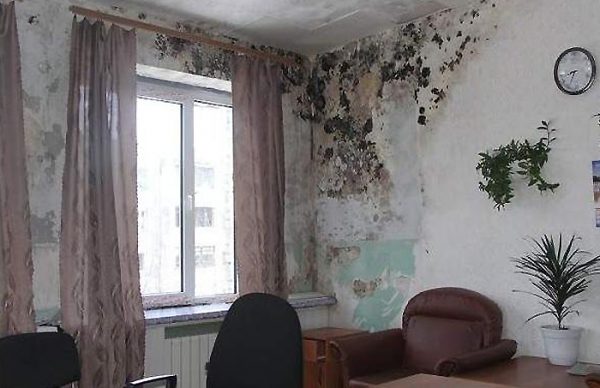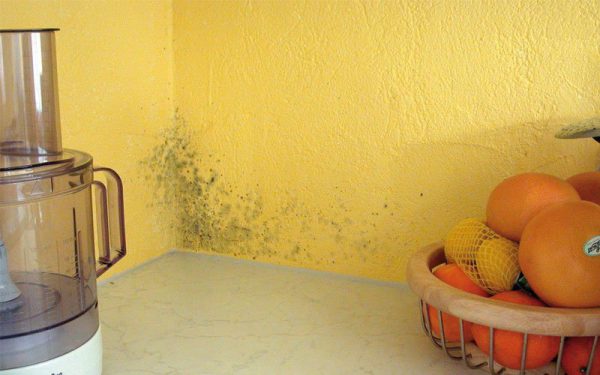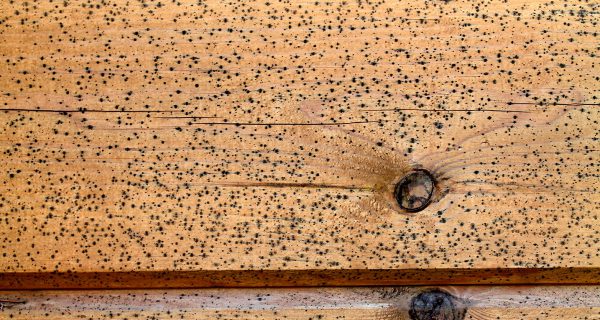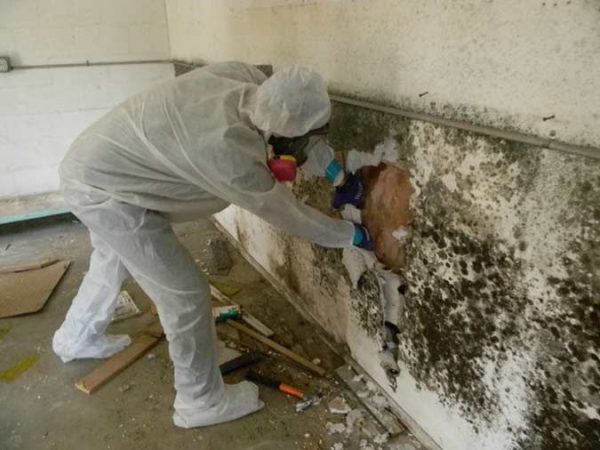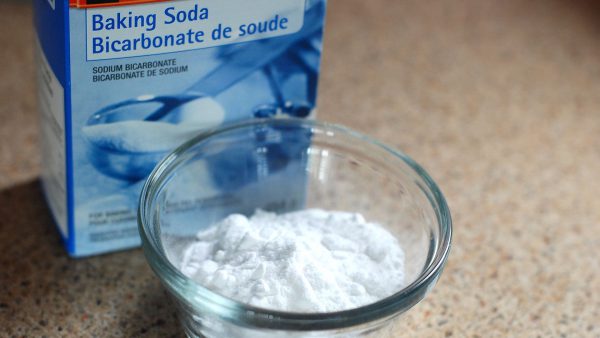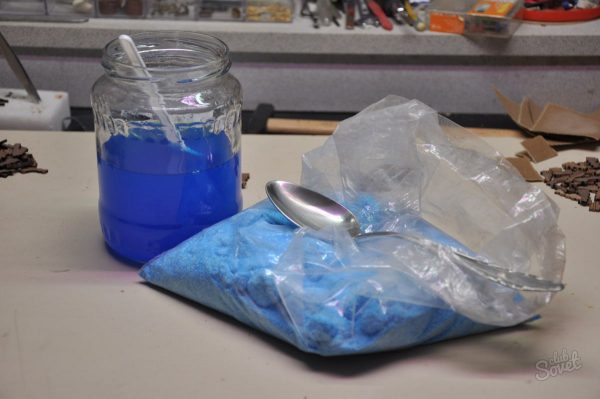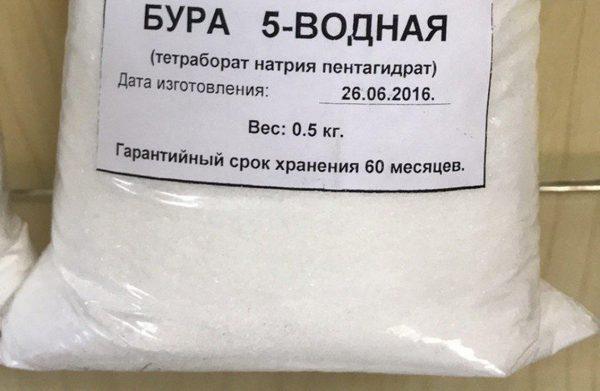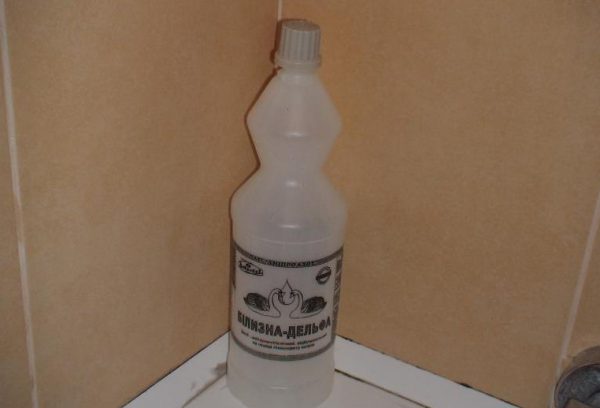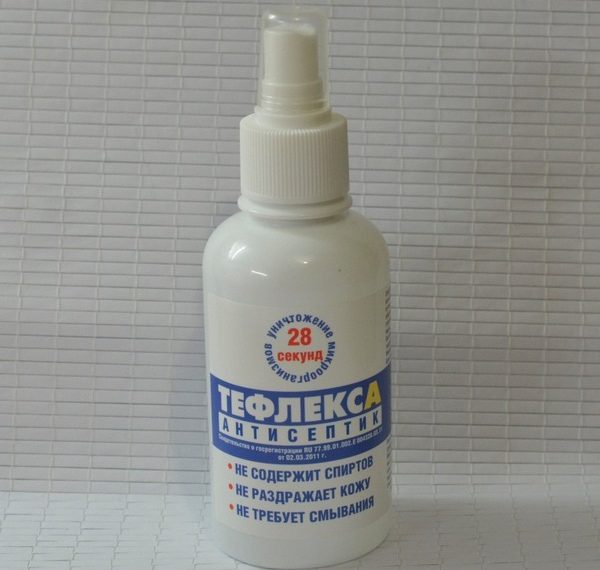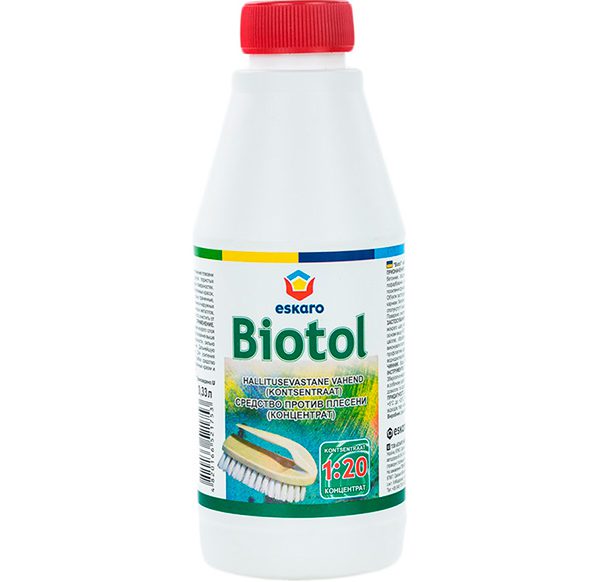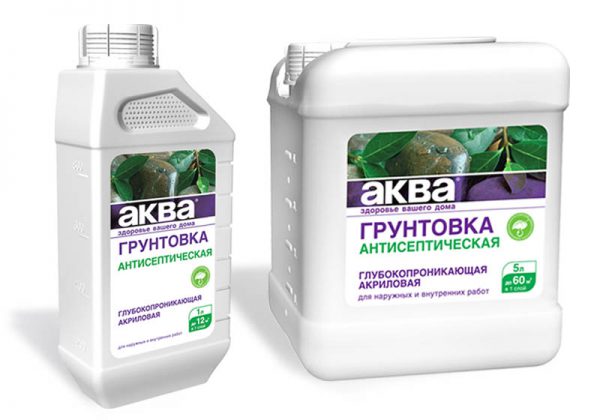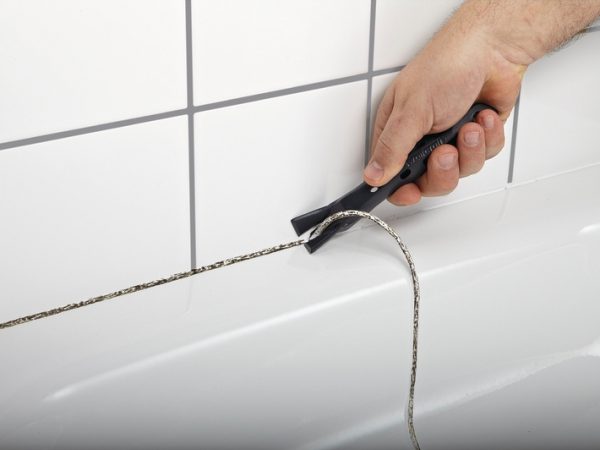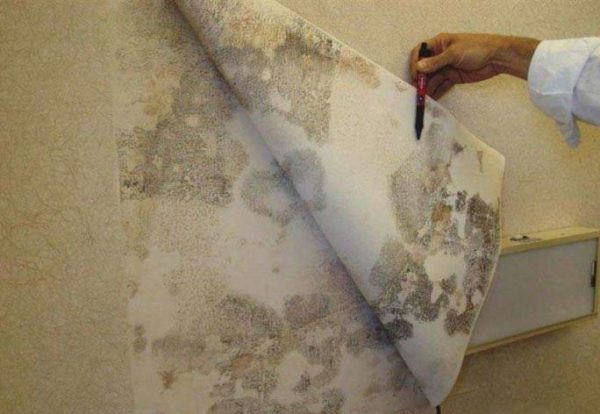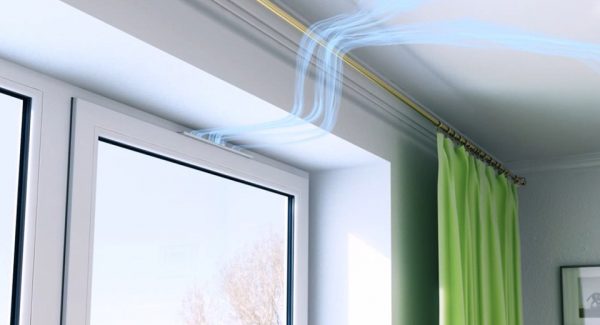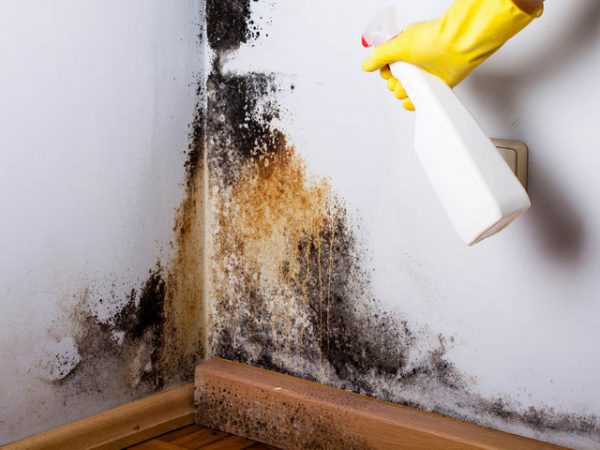The fungus on the walls, ceiling in the house and in the apartment is not just an aesthetic defect. Such microorganisms carry a real danger to human health, causing diseases of the nose, pharynx, bronchi. If you identify a problem, you must immediately get rid of it.
- Causes of the appearance of the fungus and harm to the body
- Terms and conditions of fungus removal
- Folk remedies for mold
- Soda
- Hydrogen peroxide
- Vinegar
- Blue vitriol
- Laundry soap
- Ammonia
- Borax
- Bleach
- Other folk recipes
- Special remedies for fungus
- Antiseptics in solutions
- Primers - Antifungal
- Work safety measures
- The process of removing mold from damaged areas
- Fungus removal tools
- Work in the bathroom
- Removing fungus on walls and wallpaper
- Work against fungus on wood
- Preventive measures
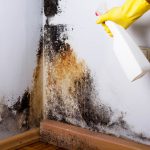
The remedy for mold and fungus on the walls is not difficult to pick up: there is a whole list of drugs and folk recipes against this scourge.
Causes of the appearance of the fungus and harm to the body
In contrast to fungi useful for humans, which are used to acidify milk and create medicines, there are also harmful species. Mold can settle in industrial premises, in living rooms and bedrooms, in the kitchen, but most often it can be seen in the bathroom or other rooms with high humidity.
The immediate cause of the appearance of the fungus is damp. Risk factors:
- humidity in the room more than 60%;
- violation of ventilation, rare ventilation of the room;
- the presence of walls with poor vapor permeability;
- errors during installation of the ventilation system;
- excessive cooling, lack of heating (for example, on the balcony);
- the presence of leaking plumbing.
Often the fungus is found in the end apartments, where it is colder than in housing with a different location. In some apartments, mold deposits are detected after the installation of plastic windows, since the microclimate in the room changes, air circulation is disturbed.
How to find fungus on the walls or ceiling? It is necessary to pay attention to black, green, yellow spots, less often they are gray-brown, pink. Some people think that such spots are just dirt, but you should not put up with it or remove it with plain water. Mold elements are responsible for the production of aflatoxins, which cause intoxication of the body and, over time, can provoke cancer.
Yellow mold is considered the most dangerous and poisonous, but other fungi produce mycotoxins, which reduce immunity and performance, can cause such diseases:
- rhinitis, otitis media, sinusitis;
- allergies, urticaria, diathesis in children;
- bronchial asthma;
- headache;
- damage to the heart and internal organs;
- skin diseases;
- diarrhea, nausea;
- stomatitis;
- conjunctivitis.
An unpleasant sight, which is a fungus, can be seen almost everywhere where there is high humidity. Microorganisms can capture brick, concrete walls, ceiling or floor, they feel great on putty, gypsum and especially on wood.
It is most difficult to remove mold from a tree, since the growth rate of microorganisms is faster, and wooden surfaces retain moisture more strongly. Furniture, wooden wall coverings are the most “popular” bases on which mold settles.
In second place for the risk of infection are loose gypsum walls and bases, on which there is a thick filler layer. Mold also appears on brick and concrete, but removal is easier.
to contents ↑Terms and conditions of fungus removal
To effectively deal with the problem and remove the fungus forever, you need to work on its causes. It is not enough to process the walls once - overhaul will help here. Finishing materials must be removed from the walls, otherwise the fungus will spread further.
Furniture, interior items, things, equipment, clothes are removed from the repaired room, and if possible, everything is disinfected. Textiles and clothes are washed at a temperature not lower than +60 degrees with powder. Furniture is wiped with antiseptics.
to contents ↑Folk remedies for mold
The easiest way to apply for wall treatment is unconventional products that are cheap and affordable. It is not recommended to remove large accumulations of fungus by such methods, since they are weaker (with the exception of copper sulfate). After the initial treatment, repeated after 7 - 10 days.
Soda
Work on getting rid of mold can be carried out using ordinary baking soda. This is a universal disinfectant that does not harm humans and pets.
Soda in the amount of a tablespoon should be diluted in a glass of water, after proceeding with the treatment of the affected areas. The solution is poured into a spray, irrigate the walls, ceiling. After an hour, you need to wash off the soda with water, wipe the base dry with a cloth.
to contents ↑Hydrogen peroxide
The product can be applied to the walls in a pure form, without dilution. Peroxide does not give harmful vapors, the liquid is not toxic. You only need to be careful with wallpaper, because the solution has whitening properties and can leave white spots on the surface after drying.
Peroxide can be used in conjunction with other components in this recipe:
- take 4 parts of water;
- add 2 parts of vinegar, the same amount of boric acid;
- add 3 parts of peroxide (3%);
- apply to the fungus, leave for an hour, rinse.
Vinegar
Using vinegar helps against mold. Table vinegar is poured into a spray bottle, irrigated walls or ceiling. After rubbing with a rag, leave for 2 hours. Then carefully wash the vinegar off the surface.
Blue vitriol
It is sold in packages in the form of a dry powder. About 100 g of vitriol should be poured into a metal bucket, add 10 liters of warm water. Stir the mixture to completely dissolve the powder. Pour the drug into the spray, treat the affected areas of the apartment. You can use a foam sponge.
The solution should dry for 3 - 5 hours, then it is sprayed repeatedly in the same places, and so on up to 2 - 5 times. In advanced cases, putty and finishing material must first be removed. It is undesirable to stay in the room for 3 days, then the vapors of copper sulfate will cease to stand out.
to contents ↑Laundry soap
Soap solution is a good antiseptic. Laundry soap is dissolved in water, then the walls are washed in a convenient way. After a couple of hours, wash off the remaining soap with water.
Ammonia
Ammonia can only be used on smooth, hard surfaces, and on porous substrates, the product will be useless. Ammonium chloride is mixed equally with water, sprayed onto the zones damaged by the fungus. Wash off with water after an hour.
Borax
Borax is called a non-toxic agent of natural origin with powerful fungicidal properties. Destroys mold and prevents its reappearance.
Before using borax, it is necessary to clean the surface with a vacuum cleaner so that particles of the fungus do not fly through the air. Then you should prepare the solution, observing the correct proportions.
A glass of borax is taken from the bag, diluted in 2.5 liters of water. The solution is applied to the base with a stiff brush, while brushing off the fungus. The borax must be allowed to dry completely, no rinsing is necessary.
to contents ↑Bleach
Many bleaches contain sodium hypochlorite or other forms of chlorine (for example, Whiteness).Such an additive is very effective against mold and can even replace professional fungicidal preparations.
Bleaches are used only on those surfaces that are white, otherwise it will not be possible to avoid ugly stains and damage to the coating. Tiles, glass can be treated with bleaches, but they are not used on drywall and wood.
Due to its toxicity, chlorine must be handled with caution. Hands protect with gloves, a respirator is put on the face. Dilute the drug 1:10 with water, apply to damaged areas with a foam rubber or brush. After complete drying, the surface is cleaned, washed with water.
to contents ↑Other folk recipes
Tea tree oil is a natural antiseptic. Pour a teaspoon of oil into a glass of water, sprinkle the walls and ceiling, where mold has settled. Rinse off the solution is not necessary - the tool is absolutely harmless to humans.
It is possible to process surfaces against a fungus also with the help of potassium permanganate solution. Pour ½ teaspoon of potassium permanganate powder into a liter of water, spray the walls or gently wipe them.
Some use clerical glue from mold. It is diluted with water 1: 1, after which the agent can treat small areas with mold.
to contents ↑Special remedies for fungus
Most manufacturers of building mixtures and paints and varnishes produce various anti-fungal agents. It is important to describe the problem to a specialist, so that the employee helps to choose a suitable product against a particular type of mold. Solutions must match the material on which they are applied, do not spoil it.
The most popular solutions:
- Atlas Mykos - implemented in the form of a concentrate, can be used for interior and exterior use, including on mineral surfaces.
- Spectrum - used on wood, putty, painted surfaces, with high humidity.
- Teflex is an environmentally friendly drug that can be applied to walls in a children's room.
On the walls you can use Antisept, Abedis, Xiolat, Snow Impregnation.
to contents ↑Antiseptics in solutions
Usually, solutions are used when the area affected by the fungus is quite large. The drugs are sold in large containers - banks, cans, have a ready-made form of application. The concentration of solutions is safe for humans.
They are applied with a sponge, erasing most of the mold. Usually 1-2 treatments are enough to get rid of the fungus, but then for prevention, you can add the product to the water to clean the room.
The list of the best solutions with fungicidal additives:
- Dali
- Fongifluid Alpa;
- Olympus Stop mold;
- Biotol;
- Mavix Bio.
Primers - Antifungal
For processing even at the construction or repair stage, primers can be used. Good funds are sold in any specialized stores, almost every brand of building materials has it. Excellent quality is noted for soils Milkill (MilKill), Terragrunt, Kremen, Lacra, Auburn.
Most products have the ability to penetrate deeply into the base pores. Anti-mold components are introduced into the smallest concrete slots, and other substances fill the pores from the outside. In order not to know the problems with mold for a long time, it is better to treat any surfaces during repairs with similar soils.
to contents ↑Work safety measures
When processing the premises, it is worth using personal protective equipment - rubber gloves, cotton-gauze dressings or pharmacy masks, respirators. It is better to wear glasses when using caustic solutions. All work is recommended in tight protective clothing.
to contents ↑After finishing the walls, you need to thoroughly ventilate the room, wash clothes, and throw the rags and sponges into a bag. If you experience allergies, nausea, vomiting, you should consult a doctor - this may be a sign of intoxication.
The process of removing mold from damaged areas
At the first stage, it is important to identify why the fungus has settled in the room. This will help to influence risk factors and prevent future problems.
It is necessary to carefully examine the affected area of the wall for the presence of voids between the plaster and the base. Tapping the wall with a hammer, you can quickly identify the place of separation of the stucco by a dull sound. Such areas need to be repaired by removing the entire site, otherwise the mold will settle in the same place.
to contents ↑
Fungus removal tools
To get rid of the problem, it is necessary to prepare rags, a basin and a bucket, a brush, a roller, a spray, personal protective equipment and a solution with a fungicidal effect in advance.
A metal spatula will be required to separate the affected plaster. Water is needed, which moistens the affected area so that the spores of the fungus do not spread indoors by air.
Work in the bathroom
The most vulnerable areas in the bathroom are the joints between the plumbing and the walls, which are usually treated with sealant. Mold most often settles in the seams between the plates, in the zone of undergrowths. If there is indelible black coating, this is probably a fungus.
Work order:
- Disconnect moldy sealant or other material on which the fungus has settled.
- Treat the site with the selected tool.
- After drying, apply sealant or another polymer repeatedly.
- If the seams between the tiles are affected by the fungus, scrape it off with a metal spatula or scraper.
- Apply grout with the addition of fungicides.
It happens that mold settles in the bathroom on the ceiling. Then you have to moisten the area with water, leave for an hour, then scrape off the plaster with the fungus. Next, you need to putty and primed the area with a special tool with anti-mold additives. As they dry, they apply another layer of soil with the ability to penetrate deeply. Then the ceiling can be sanded and painted.
to contents ↑Removing fungus on walls and wallpaper
If a fungus is noticed on the wall in the apartment, it must be removed without delay - within six months the mold will "grow" to the concrete base. Damaged finishes must be removed by sprinkling with water beforehand; all deposits should be well cleaned. After drying the wall, it is treated with a fungicidal agent.
Drywall and wood should be treated with the most powerful means, because the fungus in them spreads very quickly, penetrates deeply.
According to the wallpaper, the mold diverges completely at lightning speed, so you have to remove the entire strip or even several. After removing the wallpaper, you need to check whether the affected layer covers plaster, concrete or brick. It may be necessary to carry out major repairs, completely removing the finish.
to contents ↑Work against fungus on wood
There are special impregnations for wood, in which antiseptic and fungicidal additives are introduced. Funds from the fungus are applied to a dry surface, from which mold areas have already been removed manually.
Apply impregnation should be 3 times, at least, and each layer must be allowed to dry. At the end of the work, a primer layer is suitable for wooden surfaces.
Preventive measures
The best prevention of fungus is to maintain cleanliness and prevent dampness. On double-glazed windows it is necessary to install valves for ventilation, in bathrooms and kitchens - to install ventilation. It is important to insulate freezing walls, and in a private house to equip a strong foundation and blind area. It is necessary to check the plumbing: if there are leaks, breakdowns, otherwise the fungus will inevitably settle in the bathroom.
If the air is too humid, even heating and the installation of an air conditioner to dry the air helps. Reduces the risk of the appearance of fungus by drying clothes on the balcony rather than in the apartment, regular use of the hood in the kitchen, frequent washing of places where mold may appear, with antiseptic agents.

